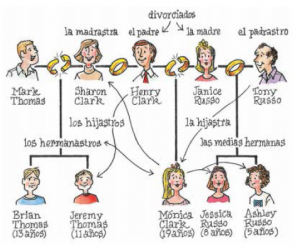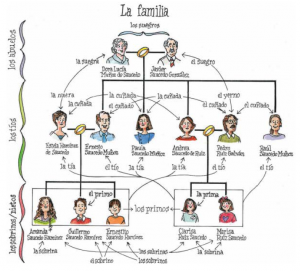I wrote this in 2011 as a graduate assignment but I believe it’s still relevant… And it was collecting dust in my cloud drive.
Dos Mundos, Comunicación y Comunidad ($176-234) claims to use a communicative design to help beginner students achieving competence in Spanish by means of comprehensible input, output activities, and explicit knowledge of rules. From Terrell’s Natural Approach (one of the authors of the original textbook) to the recent Focus on Form, Dos Mundos has experienced a relative evolution through its history responding to SLA studies and trends.
In this post I will examine the last edition of Dos Mundos (2010), a miscellaneous textbook that underemphasizes phonetics and pragmatics while emphasizing lexis and morphosyntax, the last two being treated simultaneously through input.
First, the sounds of Spanish are particularly underrepresented in the textbook, excluding ancillary materials. There is only an initial mention to the Spanish Alphabet with some spelling notes and one exercise (Dos Mundos 14-15), and the Appendix Three, which includes rules about syllabication and spelling changes, among others. None of these aspects are presented through input.
It is presumable that the authors do not emphasize the importance of phonetics because either they do not understand it as a complex issue for US students of Spanish, they expect teachers to cover this area through the oral communicative activities that abound in Dos Mundos, and/or they believe there are enough pronunciation activities and explanations in the workbook Cuaderno de actividades. Either way, after an exhaustive search, there were no references to phonetics issues or variations to be found.
The case of pragmatics is more ambiguous. Arbitrary notes about the use of language in context exist within the new section ¡Ojo! (which means Look out!). Although this information mostly refers to cultural differences and facts that are relevant to the topic, they do not blend with the input. Some of the activities also cover, superficially, pragmatics since they require students to place themselves in a Spanish speaking country. However, there is no explicit mention to pragmatics. Generally, teachers have to specifically mention –and act out– the importance of pragmatics in regards to communication through input and activities.
The authors are missing an excellent opportunity to introduce pragmatics through the grammar or vocabulary input that opens each section. This is not necessarily due to the artificial nature of textbooks since they could use or modify real situations with real pictures, instead of drawings about a family that rarely displays more than one cultural item: their Spanish last name. Even within the video resources (which are not relevant to this assignment), input is extremely adapted to language learners, avoiding pragmatics.
On the other hand, vocabulary is very important. Each chapter is associated with new vocabulary that it is presented through graphic input instead of a mere list of words –there is, for that reason, a context for lexicon elements that trigger communicative activities. It is not uncommon to find vocabulary linked to Hispanic characters, even though most vocabulary items are associated with familiar situations for college students with no reference to Hispanic cultures.


Particularly interesting is the approach to kinship lexicon (Dos Mundos, 312-313), in which the authors present a large Hispanic family with no broken unions, followed by what seems to be a US family (judging by their names) with divorced parents and children from different marriages. This unfortunate and perhaps unintended simplification represents an approach to vocabulary that could be improved with authentic pictures and different situations. The cultural contrast is necessary but it would be preferable to use real ethnography and data from different Hispanic societies. In fact, many Spanish instructors use their own material to present the same vocabulary shown in Dos Mundos (and some rarely use the textbook).
Still, the connection between vocabulary and communicative activities is reasonably successful and it gives a new dimension to the initial input. Furthermore, within each chapter, different activities provide new input which is gradually more authentic, including pictures, modified readings and authentic texts.
Elements of morphosyntax are presented in a similar way to lexicon items, which is to say, by graphic input and connections with activities. Simultaneously, both levels are combined through a series of communicative situations. Some examples are festivities, work, residence, food, trips, past and present. In these scenarios, there are not explicit references to grammar, although students are guided to use specific structures in meaningful activities. Also, each chapter includes a final section with explicit grammar explanations, and Dos Mundos asks students to read them before exposure to input.
Both explicit and implicit morphosyntax have a decisive role in the textbook. It is not just a “gentle focus on form”, (Dos Mundos, XXIII) as the authors claim, but part of its backbone, in combination with the vocabulary, activities and notional-functional vertebrae.
As a consequence, it is difficult to define Dos Mundos as a textbook that strictly follows the principles of Communicative Language Teaching (CLT), although we must remember that the CLT is a flexible approach where “drilling may occur, but peripherally” (Finocchiario and Brumfit) and “any device which helps the learner is accepted – varying according to their age, interest, etc” (ibid.).
Dos Mundos intends to “make language acquisition theory work in the classroom” (Dos Mundos XII). However, their theoretical framework is undefined. It seems to be a blend of different approaches: Krashen, Terrell, CLT, Focus on Form, and even TPR. Consequently, it would be more accurate to claim that their goal is to simply make second language acquisition work in the classroom. In order to achieve this new goal, Dos Mundos should improve the quality and authenticity of input and activities, ensuring the integration of pragmatics.

